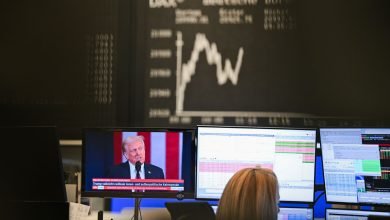Friday’s sell off is milder than Thursday’s historic sell-off
The stock market sell off has continued into Friday. The sell off is milder than Thursday’s historic sell off for risky assets, but it is a sign that buyers are thin on the ground as investors weigh up the consequences of President Trump’s tariff plans. US stock index futures are also pointing to a lower open later today, although the dollar is finding its feet after Thursday’s sharp sell off.
Central banks to the rescue
A big theme of the last two days has been increased bets on central bank easing. Yields are lower in Europe, with the largest decline in Gilt yields. The 2-year yield is lower by 10bps and has fallen by 29bps in the last 5 days, outperforming Treasuries, and most European bonds. There are now more than 3 rate cuts priced in for the UK and the Eurozone for the rest of this year. In the US, nearly 4 cuts are expected, with investors hoping that the Fed comes to the rescue if Trump’s tariff plans torpedo US growth. The large move lower in bond yields has taken the edge off the euro and the pound at the end of the week, which are both sharply lower vs. the USD, as the greenvback stages a comeback.
Historic moves
A quick re-cap of Thursday’s historic moves. It turns out that the markets had not priced in the full impact of President Trump’s tariffs and global stocks, led by the US, along with the USD sold off sharply on Thursday. The S&P 500 fell nearly 5%, the Nasdaq fell 6%. Some notable decliners included a 19% decline for Dell, and a 9% decline for Apple. The Bloomberg dollar index had its largest intraday decline ever at one point on Thursday, before closing down by 1.5%, its largest daily loss since 2022.
US and Asian stock indices have been hit the hardest so far, with Europe showing more resilience, and Australian and UK stock markets performing the best on a relative basis. The excessively high valuation of the S&P 500 has taken a knock recently, and it is currently trading at 22.25, below its 5-year average, however, it is still significantly higher than P/E ratios for European stocks. Thus, if there is a secular shift away from US equities, then we would need to see the S&P 500’s P/E ratio fall even further, potentially below 20, before this sell off is over. Nvidia, at one point the world’s most valuable company, is lower by 25% YTD, and its price to earnings ratio is now 34, at the start of this year it was nearly at 60.
Japanese shares have also seen their valuations take a hit. The Nikkei is now trading with a P/E ratio of 17, at the end of 2024 it was 20. This drop is the largest out of the major global stock indices. The Eurostoxx 50 index has a P/E of 14 and the FTSE 100’s P/E ratio is 12, so the US still looks expensive by international standards.
Bears make themselves at home
Bear markets are starting to creep up on US small cap stocks and the Nasdaq. The Russell 2000 is down nearly 15% YTD, along with the Nikkei. The Russel 2000 is down nearly 20% since its November peak. This comes at a time when the hard economic data in the US is still relatively strong, and the US economy is expected to have created 140k jobs last month. Fears about the impact of President Trump’s reciprocal tariffs have completely changed the outlook for US stocks, with small and mid-cap stocks underperforming the broader blue-chip index.
When will stocks recover?
Is it time for US stocks to stage a recovery, or is it too early to catch a falling knife? Trump’s tariffs have brought to an end the era of American exceptionalism, and with it enthusiasm for US stocks. Fears about the AI trade are exacerbating the sell off, and without a reversal from the Trump administration, it is hard to see the US stock market attracting many bidders at this point. The S&P 500 experienced a 5- standard deviation daily move on Thursday based on the past 12 months, this is a rare event and we do not think that this will persist. The sell off may ease on Friday, however, we do not think that US stocks, or other tariff hit global indices will stage a decent recovery until 1, US trade policy is scaled back, or 2, Peter Navarro, the architect of President Trump’s reciprocal tariff agreement is fired.
Looking ahead, payrolls data is worth watching, although it will take a number of months before we know the impact of US trade levies on the labour market.
The material on this page does not constitute financial advice and does not take into account your level of understanding, investment objectives, financial situation or any other specific needs. All information provided, including opinions, market research, mathematical results and technical analyzes published on the Website or transmitted To you by other means, it is provided for information purposes only and should in no way be construed as an offer or solicitation for a transaction in any financial instrument, nor should the information provided be construed as advice of a legal or financial nature on which any investment decisions you make should be based exclusively To your level of understanding, investment objectives, financial situation, or other specific needs, any decision to act on the information published on the Website or sent to you by other means is entirely at your own risk if you In doubt or unsure about your understanding of a particular product, instrument, service or transaction, you should seek professional or legal advice before trading. Investing in CFDs carries a high level of risk, as they are leveraged products and have small movements Often the market can result in much larger movements in the value of your investment, and this can work against you or in your favor. Please ensure you fully understand the risks involved, taking into account investments objectives and level of experience, before trading and, if necessary, seek independent advice.






